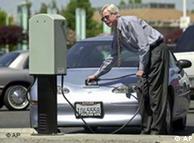Denmark turns to green transport in runup to climate summit
(Source: Deutsche Welle)

But with every Dane pumping out 5 tons of CO2 into the atmosphere each year, Copenhagen could find itself in a tricky position as the host of a giant climate summit at the end of this year, when delegates from all over the world get together to set new global targets on emissions ahead of the 2012 expiry of the Kyoto agreement.
That’s why today a different message is heard coming from Copenhagen and the vision of green economic growth is sprinkled throughout just about every speech Rasmussen gives.
The prime minister is now openly advocating “a society in which we are completely independent from fossil fuels like coal, oil and gas” and a future in which renewable wind, solar and biomass energy sources will make it possible to live in “houses that produce more energy than they use.”
Currently there are only about 200 climate-friendly autos on the nation’s streets, but that should grow to 100,000 within two years.
The Danish energy corporation DONG and the American company Better Place are planning to invest 100 million euros ($135 million) to build up infrastructure in the country for electric cars. The idea is to make it just as fast to charge up a battery as it is to fill up a tank of gas.
The head of the Danish electric auto association, Per Moeller, is very pleased with that plan, and confident that Denmark can become a pioneer in this sector.
“We have really good conditions for it here: no extreme climate changes and a flat landscape,” he said. “Denmark is certainly one of the countries in which it would be the easiest to introduce electric cars.”
The batteries to run these cars of the future have another advantage. They can be charged during the night when energy from wind turbines is available but isn’t being used much, essentially turning them into important energy storage devices.
“I don’t think we can leave it to the politicians to solve the problems with climate change,” said Jens Moberg, CEO of the Danish branch of Better Place. “Consumers and companies need to take an active role in the process.”
